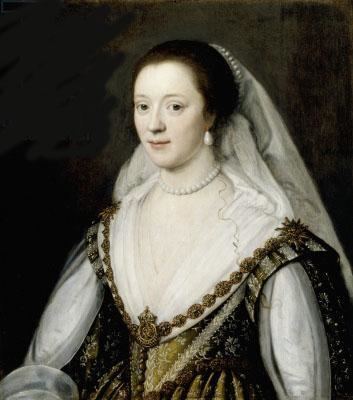Name Frances Viscountess | ||
 | ||
Frances Coke, Viscountess Purbeck (1601 – May, 1645), was the sister-in-law of George Villiers, 1st Duke of Buckingham, and the central figure in a notorious sex scandal within the English aristocracy of the early 17th century that was known at the time as “the Lady Purbeck’s business”.
Contents
Early life
Frances Coke was the younger daughter of the judge and privy councillor Sir Edward Coke and his second wife Lady Elizabeth Hatton.
Forced marriage
In 1617, her father betrothed Frances against her will to Sir John Villiers, 1st Viscount Purbeck. Villiers was the elder brother of George Villiers, 1st Duke of Buckingham, the favourite of King James VI and I. The match was an apparent bid by Sir Edward Coke to win back royal favour, following his dismissal as Lord Chief Justice and from the Privy Council.
Both Frances and her mother opposed the marriage. Lady Hatton sent Frances away from Hatton House in Holborn, on 10 July, without informing her father. Lady Hatton's plans involved a rented house and her extended family of cousins. She placed her daughter first with Lady Withipole; she was the former Frances Cornwallis, daughter of Sir William Cornwallis of Brome. The next step would be a pre-emptive betrothal to Henry de Vere, 18th Earl of Oxford.
Sir Edward Coke located his daughter Frances, by chance on his own account, at a house near Oatlands, rented by Sir Edmond Withipole from the Earl of Argyll, and took her away. By legal means he had her kept at the house of Sir Henry Yelverton, the Attorney-General; and then at the house of Thomas Knyvet, 1st Baron Knyvet, who owned Staines. It was rumoured that Frances was “tyed to the Bed-Poste and severely whipped into consent”. In September 1617, she was married to Viscount Purbeck at Hampton Court in the presence of the King and Queen.
Aftermath of marriage
The marriage was an unhappy one. Viscount Purbeck was said to suffer from bouts of insanity, and to withhold money from his wife. In 1621 the pair separated.
In October 1624, Frances gave birth to a son who was baptised as Robert Wright. Rumours began that the child’s father was Sir Robert Howard, a son of the Earl of Suffolk. In January 1625, King James signed a warrant for the trial for adultery of the couple in the ecclesiastical Court of High Commission. However, as her biographer points out, “The prosecution of Lady Purbeck was pretty clearly at the instigation of Buckingham and not of Purbeck.” In fact, the Duke seems to have become obsessed with his sister-in-law’s behaviour and appears to have accused her not only of adultery but also of witchcraft. In February 1625, he urged the Lord Chief Justice to imprison both her and Sir Robert Howard. Howard was confined in the Fleet Prison and Frances put under house arrest at the home of a London alderman. In March 1625, Howard was publicly excommunicated after he refused to answer to the charge against him and the proceedings were suspended.
The trial resumed in November 1627 under Archbishop Laud and Frances was convicted of "incontinency", or adultery. Among her twenty commissioner-judges (only one of whom, Sir Charles Caesar, dissented from the judgment by absenting himself) was the poet John Donne, who was then Dean of St Paul's Cathedral.
Later life
Frances failed to perform her penance of standing barefoot in a white sheet in church and was again put under house arrest. She escaped by disguising herself as a page-boy and fled from London to France where she lived in exile in Paris for several years with her son. She converted to Roman Catholicism and lodged for a time in a convent although she did not become a nun. In early 1640, Frances petitioned the House of Lords for the return of her ₤10,000 marriage payment which had been appropriated by the Villiers family although she seems to have been unsuccessful. Eventually she returned to England where she died at Oxford at the Court of King Charles I of England in May 1645 at the age of about 44. She is buried in the University Church of St Mary the Virgin.
In literature
In the dramatist Ben Jonson's masque The Gypsies Metamorphosed (1621), the Second Gypsy addresses Lady Purbeck (who was among the audience) as follows:
During her exile in Paris, Sir Kenelm Digby wrote of her: “I have not seen more prudence, sweetnesse, goodnesse, honor and bravery shewed by any woman that I know, than this unfortunate lady sheweth she hath a rich stock of. Besides her natural endowments, doubtless her afflictions add much; or rather have polished, refined and heightened what nature gave her.” Arthur Wilson, the early historian of the reign of King James VI and I, wrote in 1653 that she was “a Lady of transcending beauty, but accused for wantonness".
A new biography by historian Joanna Luthman, Love, Madness & Scandal: The Life of Frances Coke Villiers, Viscountess Purbeck, is due to be published by Oxford University Press in May 2017.
